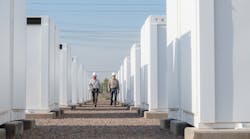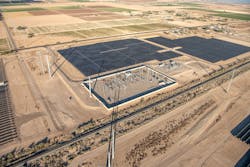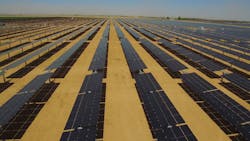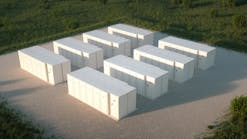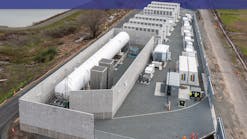SRP Learns From Past Storage Technology Deployments
In the rapidly growing Phoenix, Arizona, U.S., metropolitan area where hot summer temperatures, intense monsoon storms, population growth and regional resource adequacy challenges continue to stress the energy grid, Salt River Project remains committed to providing reliable power to around 1.1 million customers. Peak electricity demand in the SRP’s service territory is forecasted to grow by approximately 900 MW by 2025, which represents a 12% increase from today. This amount of power equates to serving about 200,000 average size homes.
This generation capacity does not currently exist in the market, meaning SRP needs to acquire or build new power generation resources as well as storage resources to serve this rapidly increasing demand. Battery storage systems represent a promising technology to help serve the demand. For this reason, SRP is an early adopter and one of the Western region’s largest investors in this evolving technology. However, SRP also recognizes the electric utility industry still needs more operating experience with this technology before it can rely on batteries to support transition to zero-carbon generation resources.
Power Resource Portfolio
SRP continues to strengthen its resource planning strategy by developing a diverse and reliable power resource mix. It has chosen an “and” strategy to meet its customers’ needs, which means it is investing in a wide variety of resources, including utility-scale solar, flexible natural gas, wind, biomass, pumped hydro storage and others. As a not-for-profit, public power utility, SRP typically has sought many of its renewable generation and storage projects through power purchase agreements with developers.
Battery systems have become one of the only relatively quick-to-deploy options for adding more renewable resources with energy output and storage capabilities when needed on the power grid. The ability to implement them in a timely manner is largely driven by their regulatory and siting processes, which do not require considerations for fuel or water availability.
Batteries also present unique, multifaceted value. One key asset is their ability to store energy at a lower cost and deploy it when demand is highest and energy generation most expensive — such as during peak demand periods that occur in the early evening hours of summer. This benefit is extremely valuable in the Phoenix market, where summer temperatures often exceed 110°F (43°C). Batteries also have fast-ramping capacity and peaking capacity, meaning once charged, they can be available on the grid very quickly.
SRP has been an early adopter and investor of storage technology and resources while also transforming its system to be more sustainable. Its battery storage capacity is expected to total 1100 MW by the summer of 2024, which is significant compared to a total of only 8000 MW in the entire U.S. as of late 2022.
Looking Back To Move Forward
With the battery storage projects SRP will have on-line in just a couple of years, its storage capacity will be capable of providing more than 10% of the expected peak-hour electricity demand. As a result, SRP will rely more greatly on this technology and need additional operational knowledge. With each new storage project underway, SRP and other electric utilities need to use data and information gained from what did and did not work with previous battery projects to inform future decisions.
Based on growing industry understanding of the Dorman event and similar failures, technology and designs of battery storage have improved dramatically. Battery energy storage systems (BESS) are now often designed in external cabinets, so if a battery fire were to occur, it would be extremely isolated and only impact cells inside the individual storage cabinet, as opposed to the possibility of impacting other units in the same storage facility or building.
Both of SRP’s pilot battery projects, though smaller in scale compared to new systems it is bringing on-line, have provided insight and important operational data to SRP, which the utility industry can build on. As these pilots are developer owned and operated, SRP previously needed to submit dispatch schedules to developers 24 hours in advance of the batteries’ deployment on the grid. This limits the operational value to SRP because much can change within a 24-hour window, including the optimal time for the storage to be deployed. SRP learned the value of having direct oversight of these systems’ charging and dispatching. Having this control and insight is now a necessary facet SRP includes in all storage resource contracts.
Projects In The Works
SRP’s Bolster substation battery, the largest currently on its system, came on-line in September 2021. The 25-MW, 100-MWh grid-charged battery uses Tesla Megapacks and can be recharged overnight, then used during times of peak energy usage to help counter rising demand. SRP has direct dispatchability of this system and gathers data on the system’s operations throughout the year, including the best times to deploy its storage as peak demand periods change from season to season.
SRP likely will use battery storage for some of its flexibility-related operations, too, which could mean managing overgeneration of power during the spring or ramping up to quickly meet peak demand periods in the fall. In addition, SRP recently began testing market utilization of this battery as a participating resource in the Western Energy Imbalance Market.
SRP also announced several upcoming grid- and solar-charged battery storage projects, including Sonoran Energy Center. Announced in 2019, the 1040-MWh BESS will be the largest solar-charged battery system in Arizona when it comes on-line in 2023. Also planned to come on-line in 2023, the Storey Energy Center in Coolidge, Arizona, will be an 88-MW, 264-MWh BESS charged by utility-scale solar. In January 2022, SRP announced an additional 100 MW and 400 MWh of battery storage to be added to its existing Saint Solar facility in 2023. SRP further increased its commitment to batteries in October 2022 with the announcement of two new projects that will add a combined 340 MW of energy storage using Tesla Lithium-ion technology.
SRP also will seek approval from its board of directors soon on a long-duration storage project at its Copper Crossing Energy and Research Center in Florence, Arizona, to add up to three storage pilot projects using emerging non-Lithium-ion technologies.
Opportunities And Challenges
Storage projects have become an integral part of most utilities’ resource planning processes, especially as utilities across the Western U.S. region, including SRP, retire their fossil-burning resources. Utilities have a greater reliance on batteries for activities like smoothing out variability from renewables and providing support during other fluctuations and system events.
However, ongoing supply chain issues have added strain on the transition to renewable resources, with raw materials for BESSs becoming increasingly difficult and expensive to acquire. In addition, most sizable battery projects on the U.S. grid are less than a decade old. Developers and utilities are still learning how these systems fit into the larger operational picture with similar levels of reliability as other more traditional resources.
Managing the battery discharge and charge cycles to serve customers reliably and cost effectively is a top priority, but this can be complicated by restrictions and requirements from developers. The industry also does not know how long new battery technologies will last in a desert environment. The batteries SRP is currently deploying only have capacity for up to four hours of storage and, like any resource, they cannot provide all their reliability functions at the same time. This means operational decisions, such as when and how to use batteries, will need to be made on an ongoing basis, which will affect their ability to support increasing demand.
The utility industry is still grappling with how batteries will provide enough capacity and flexibility to reliably transition to zero-carbon resource portfolios. Until utilities have a better grasp on how batteries will be a trusted solution to adding more renewables, traditional thermal generation must still play a role in continuing to achieve low-cost, reliable power for customers. As SRP continues to add more renewable resources, it also will need to add flexible resources, such as quick-ramping natural gas, to its portfolio to ensure a reliable power supply.
Innovating And Adapting
The need to shift to more sustainable technologies is urgent, but it is just as critical to ensure the transformation happens reliably and successfully. Failing to plan and prepare for long-term growth and increasing electricity demand is a surefire way to increase the risk of regional power shortages.
With the changing dynamic and increased pressure on the electric sector to achieve broad environmental and societal goals, traditional resource planning methods are becoming insufficient. Electric utilities also must partner with stakeholders across industries to optimally develop a safe, reliable, affordable and environmentally responsible power system. SRP is currently doing this through its integrated system plan.
Batteries will help SRP to meet rising energy demand in the near term and also act as the foray into incorporating a more diverse storage resource future. SRP will continue to evaluate its storage portfolio while investigating long-term options that will ensure a sustainable, reliable and affordable energy supply. These include additional pumped hydro and small modular nuclear technology. There is still much more for SRP and other utilities to learn, and many in the industry plan to use these next several years learning as much as possible from the storage technologies currently being developed and deployed.
Chris Janick ([email protected]) is senior director of power delivery at Salt River Project (SRP), where he has worked since 2000. Prior to serving in his current role, he oversaw several other departments at SRP, including as director of protection, automation and control; director of electric reliability compliance; and plant manager of SRP’s Agua Fria generating station in Glendale, Arizona. He holds a bachelor’s degree in chemical engineering from Arizona State University.
